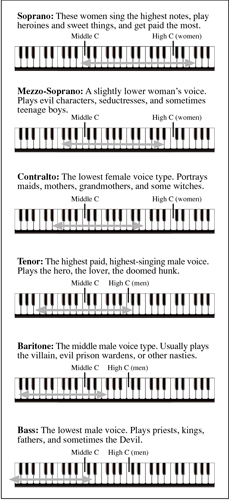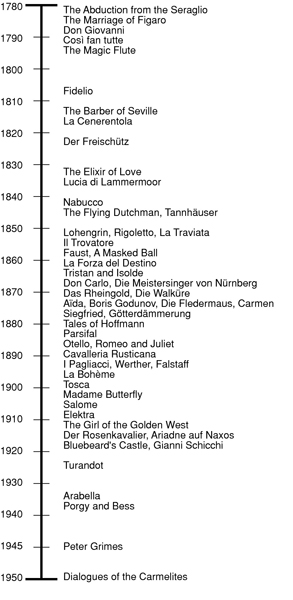As an opera fan, you may be familiar with the range of opera voices and basic opera terms. If you’re a more recent aficionado, you may benefit from tips on how to choose an opera to attend and what to do when you’re at the opera house. And any opera lover can benefit from scanning a timeline of some of the greatest operas ever written.
>
>
Opera Voices and Their Ranges
In opera, you can subdivide the human voice into dozens of finely differentiated categories, but the following figure shows the Big Six and their ranges shown on a piano keyboard:

>
>
>
Tips for Choosing and Attending an Opera
Going to a live opera performance isn’t like going to a movie. For one thing, you’re paying ten times as much for a ticket. For another, you’ll be experiencing some pretty strange sights and sounds. Follow this checklist for best results:
Choose the right opera. Operas — their music and their stories — are 100 percent as varied as today’s movies. Some are delightful romantic romps, such as The Marriage of Figaro and The Elixir of Love. The majority are heart-rending love tragedies, like La Bohème and Aïda. A few are nearly X-rated shockers featuring adolescent mother-killers (Elektra) or teenage necrophiliacs (Salome). Don’t walk into something you’re not ready for — especially if you’re on a hot date.
Get to know the opera in advance. The opera’s probably in a foreign language, it may be set in an exotic time and place, and it may have a complicated plot. By renting the video or listening to the CD (while following the words) beforehand, you’ll be familiar with the story going into the gate. Your opera-going experience will be 50 times better.
Eat. Going to an opera isn’t like going to Fiddler on the Roof — it’s probably much longer, especially if Richard Wagner wrote the show. Eat something light before you go, and then have a full dinner afterward. (Unless it’s Wagner. Then take food to the show, which you can scarf down during the intermissions.)
Arrive early. The people-watching alone is worth the ticket price. How many opera snobs can you find?
Check out the orchestra pit. The instrumental musicians — half the opera’s payroll — will be hidden from view all night. Before the show starts is the time to witness all the action down there, including all the strange warm-ups that the orchestra players go through.
Hit the restroom before the curtain goes up. Your next opportunity may be the intermission, which may be hours away. Moreover, the 2,000 audience members will be trying to get into a restroom designed to hold 6. Ladies: This especially means you. Unless you want to stand in a line that could stretch to the moon and back seven times, go before the show.
>
>
>
Opera Vocabulary
You’re at the opera house. You open the program book or you’re listening to the opera snobs talk, and you can’t understand a word — or at least some words. To get a handle on what they all mean, check out the following list:
| aria: An emotion-expressing song in an opera; the big number. | opera buffa: Funny opera, especially from the 18th century. |
| bel canto: A style of sweet singing, taught to singers even today, that emphasizes breath control, a beautiful tone, and great flexibility in dynamics (going from loud to soft, for example). | opera seria: Formal, serious opera, especially from the 18th century. |
| cadenza: A moment near the end of an aria for the singer alone, with lots of fast, high, difficult notes, designed for showing off. | prima donna: The singer who plays the heroine, the main female character in an opera; or anyone who believes that the world revolves around her. |
| coloratura: A singer (usually soprano) with an extremely agile, light, pure-sounding voice, capable of easily singing fast, high notes. | recitative (“ress-it-uh-TEEV”): Speech-singing, in which the singer semi-chants the words, imitating the free rhythms of speech. |
| dynamics: The loudness or softness of a musical composition, or the markings in the sheet music that indicate volume. | Singspiel (“SING-shpeel”): A German opera with spoken dialogue (instead of recitative) between arias. |
| Leitmotif (“LIGHT-mo-teef”): A little melody that plays every time a certain character or object appears; invented by Richard Wagner. | trouser role: A man’s part played by a woman. |
| libretto: The script of an opera. | verismo: A realistic, “documentary” style of opera that depicts the seamy underbelly of life. |
>
>
>
Timeline of the Great Operas
What are considered great operas today have stood the test of time for hundreds of years — even thousands. The following timeline shows the progression of great opera from the 1780s to the middle of the last century:

>
>
dummies
Source:http://www.dummies.com/how-to/content/opera-for-dummies-cheat-sheet.html
No comments:
Post a Comment